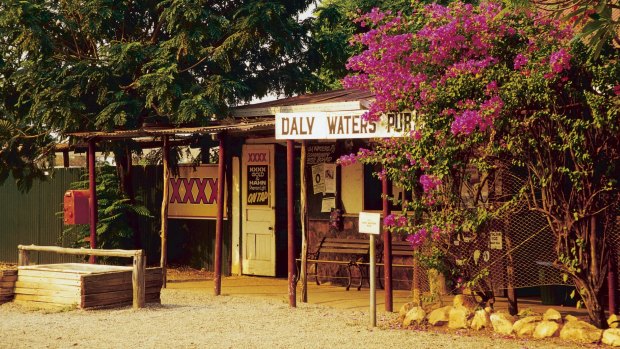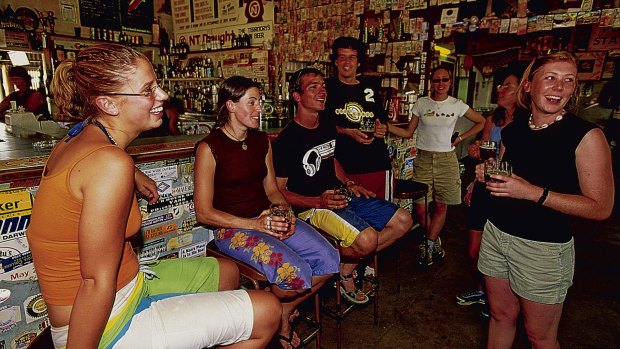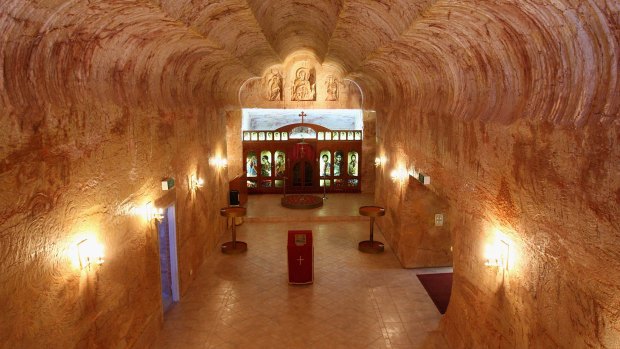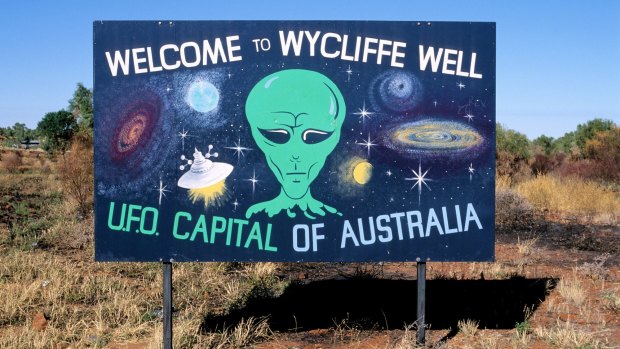This was published 9 years ago
Australia Stuart Highway road trip complete with UFOs

A local rakes out the green at the Coober Pedy Golf Course.Credit: Getty Images
"What's that?"
As the ceremonial first bite of the roadtrip-starting bacon sandwich sinks in, something scurries across the floor of the Port Augusta service station. It is, at best, a mouse. Suddenly the sandwich doesn't seem all that appetising.
It's good to set a marker for what's ahead, and the sight of the furtive rodent dispels any remaining illusions that the next 2834 kilometres are going to be full glamour. Driving the entire length of the Stuart Highway is not a mission to be undertaken with any apprehensions of pampered luxury. The vast majority of the trip is a brutal slog through barren, yet oddly wonderful, nothing. Most settlements along the way are little more than a roadhouse with a couple of shacks tacked on. Anything larger than that tends to be very weird indeed. Yet taken as a whole it is one of those adventures that feels like an Australian rite of passage.

Daly Waters Pub, the oldest pub in the Northern Territory.
The Stuart Highway is named in honour of John McDouall Stuart, who was born 200 years ago on September 7, 1815. The crotchety Scotsman was, over the course of six gruelling exploratory expeditions, the first man to cross the Australian continent from south to north. The highway largely follows his route.
Whereas now it's a tough slog of a drive, back then it was a truly exceptional feat. There is no permanent source of running water in the 2400 kilometres between Port Augusta and Katherine, and Stuart's party travelled with minimum resources, surviving on whatever meagre rations they could find on the way across a stark landscape.
Leaving Port Augusta, there's an air of resignation. Seemingly endless nothing lies ahead. But it turns out that seemingly endless nothing is far more impressive than first imagined.

Happy hour drinks at the Daly Waters Pub.
The sheer scale of the starkness, unfolding across the horizon and probably several horizons beyond that, is electrifying. The sense of isolation, of being much smaller than you ever previously imagined, feels oddly liberating. Gentle rises in elevation lead to phenomenal viewpoints, simply because there's nothing else in the way.
It is the sort of land that is perfect for firing rockets into, and that's exactly what happens. Significant chunks of the Stuart Highway's South Australian section pass through the Woomera Prohibited Area – and the deeply weird military township which the exclusion zone takes its name from is the first real stop.
The small visitor centre there provides a deeply, and some would argue suspiciously, sanitised version of what has gone on in these parts over the years. Just a bit of scientific research, you understand.

The Underground Serbian Orthodox Church in Coober Pedy.Credit: Getty Images
The missiles lined up on display outside the local school would suggest Woomera's experiments haven't exactly been about peace and love, however.
Slightly further on, the highway skirts by Lake Hart. It's not the biggest of the giant salt lakes that cover much of the South Australian outback, but it's the most accessible. A few steps across the train tracks, and feet find themselves by the cracked, icy-looking saltscape. It's a place seemingly stripped of life, struck with an eerie otherworldliness.
If Lake Hart is surreal, though, Coober Pedy is downright bizarre. Since the first opal was found here in 1915 by a 14-year-old boy, miners have flocked from all over the world to dig for their fortune. This has led to a surprisingly cosmopolitan community in the heart of the Outback. Italian clubs, Chinese restaurants and Greek cafes dot the dusty streets, while a Serbian orthodox church has been tunnelled out of the earth.

Aliens welcome: Numerous UFO sightings have been reported at Wycliffe Well.Credit: AFP
The latter would be unusual anywhere else, but here, living underground is the norm. Around 80 per cent of the homes in Coober Pedy have been dug into the hillsides in an attempt to escape the savage desert heat.
Faye's Underground Display Home allows visitors to get a glimpse of what these troglodyte abodes are like. Entirely excavated by hand, it first started life as garage for Coober Pedy's mailman before being expanded into a three-bedroom home.
It's not as basic and Spartan as you might imagine. A maze of bedrooms slinks further and further underground, but there's also a thoroughly useless fireplace made from semi-precious jasper stone. Upstairs, however, there's an indoor swimming pool. People, it seems, haven't come here because they love the desert – opal mining has some significant perks.
After a few days on the Stuart Highway, a few realisations dawn. Firstly, you can forget about good food. Asking where the best place to eat in Coober Pedy is leads to the pithy response of: "Mobil service station."
Secondly, any speed limits are purely theoretical, as for the bulk of the time, you'll be stuck behind something. The much-feared road trains aren't the biggest menace – a bit of stealthy middle-of-the-road positioning and a hard blast on the accelerator, and they're vanquished. Far more of a nuisance are caravans travelling in convoy. Getting round two or more in one swoop takes precision timing and faultless nerve.
You also find yourself lulled into a certain mode of carefree, uncomplicated donkey work driving. Reality and the normal way of doing things get left behind. And the first roundabout to emerge on entry to Alice Springs comes as something of a shock. What the hell are you supposed to do with these things?
The Northern Territory leg of the highway has a different feel to it. The landscape subtly changes, becoming greener and less dramatically supersized. Large termite mounds can be seen to the side, and roadhouses appear more frequently. Each seems to have its own gimmick, whether it's camel rides at Stuart's Well or an injured eagle strutting up and down a perch outside Aileron.
Winning the gimmick wars hands down, however, is Wycliffe Well. The grounds are full of plastic aliens and cheaply homemade spaceships, plus the occasional wooden Elvis.
Inside, the reason for the extra-terrestrial paraphernalia becomes clear. A barrage of newspaper clippings explain the numerous UFO sightings that have occurred here over the years. This is, apparently, the UFO capital of Australia – and the owners are going to stick that story through hell or high water.
The greatest of the Stuart Highway's overnighters, however, arrives once the desert has properly started to lose the battle to the tropics. Daly Waters has a non-functioning traffic light, permanently on red to trick visitors into staying, and one of the undisputed classic outback pubs. Walls are covered in bank notes from all over the world, while a forest of bras donated by previous visitors hangs down from the ceiling near the pool table. Happy hour drinks get everyone well oiled, and excessive lubrication continues way beyond the steak and barramundi barbecue and live band. It's all about getting to a state where you don't care too much about the spiders in the cabin.
The last leg on the Stuart Highway is the one that takes the longest, largely due to the wealth of highly appealing detours. The final 600 kilometres is back in the land of the ever-flowing water, more croc than camel territory, and the Kakadu, Nitmiluk and Litchfield National Parks lie just off Mr Stuart's track. The mood goes from pummelling through the outback to leisurely exploring the Top End.
But the end of the line comes in Darwin, and with most feeble fanfare imaginable. The Highway simply merges into Daly Street in the Darwin CBD, like a whale being swallowed by krill.
A judicious decision is taken to ignore this. The true end shall be the end of Daly Street.
The car – by now disgustingly filthy – is parked up, and weary footsteps are taken across the parkland until John McDouall Stuart's target comes into view. The sight of the Timor Sea sends bursts of pride pulsating through the body. Quite how it must have felt for a man who crossed the continent on foot is a different matter.
TRIP NOTES
MORE INFORMATION
southaustralia.com, travelnt.com.
GETTING THERE
Virgin Australia flies to Adelaide and Darwin from both Sydney and Melbourne. See virginaustralia.com.
STAYING THERE
Majestic Oasis Apartments, Port Augusta: Waterside apartment-style accommodation for from $130. See oasisportaugusta.com.au.
Desert Cave Hotel, Coober Pedy: Stay underground like the locals for from $255. See desertcave.com.au.
Quest, Alice Springs: Apartments with an outdoor pool for from $159. See quest apartments.com.au
Wycliffe Well Holiday Park: ET-infused, motel-style ensuite doubles for from $129. See wycliffe.com.au.
Daly Waters Pub, Daly Waters: Cabins to stagger thoroughly obliterated into from $130. See dalywaterspub.com
Knotts Crossing Resort, Katherine: Motel meets budget resort, with rooms for from $115. See knottscrossing.com.au.
TOURING THERE
Major hire car companies can be found at both Adelaide and Darwin airports. Check Vroomvroomvroom.com.au for deals. 4WDs are not needed for the Stuart Highway, but are for some more remote detours along the route.
THE STUART HIGHWAY: FIVE THINGS TO DO EN-ROUTE
RAINBOW VALLEY Just south of Alice Springs, these multi-coloured free-standing sandstone bluffs tend to get ignored in favour of the Red Centre's bigger name attractions. The wow factor is high, though. See parksandwildlife.nt.gov.au.
ROYAL FLYING DOCTOR SERVICE, ALICE SPRINGS The Flying Doctor base serving even more remote areas of the Outback than the ones the Stuart Highway passes through offers an utterly fascinating insight into how medical care is administered to remote stations and Aboriginal communities. See flyingdoctor.org.au.
THE DEVIL'S MARBLES A short drive from Wycliffe Well, these mysterious stacks of boulders are best seen at dawn or dusk when the light brings out the colours. The local Aboriginal groups traditionally believe the boulders are the eggs of the Rainbow Serpent.
THE SCHOOL OF THE AIR, KATHERINE What the Flying Doctors do for medicine, the School of the Air does for education. Kids in remote communities are connected together with web link-ups. Tours allow visitors to sit in on the lessons and see how it all works. See web.ntschools.net/w/ksa.
KATHERINE GORGE Travel through the succession of towering sandstone gorges of the Nitmiluk National Park by boat or canoe. See nitmiluktours.com.au.
Sign up for the Traveller Deals newsletter
Get exclusive travel deals delivered straight to your inbox. Sign up now.